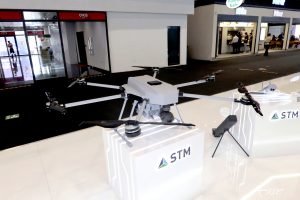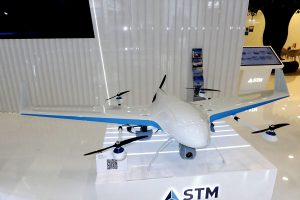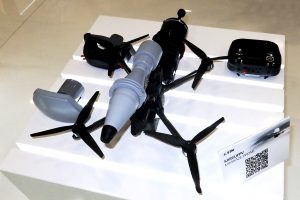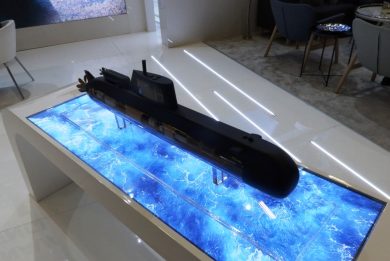
IDEF 2025 – STM unveils new loitering munitions and munition carrier UAVs
Well known for its Alpagu and Kargu killer drones, which have been around for nearly one decade, anticipating the loitering munitions era, the Kargu has been exported to more than 10 countries across three continents, STM of Turkey introduced a series of new unmanned lethal air systems at the IDEF exhibition
While developing a family of fixed-and rotary-wing loitering munitions, STM (Savunma Teknolojileri Mühendislik ve Ticaret A.Ş., Defense Technologies Engineering and Trading Inc.) looked at modularity as a key issue, to reduce development costs, logistic footprint, and training issues.

Starting from rotary-wing systems, STM had in its portfolio the Boyga, a quadcopter with a maximum take-off mass of 17 kg, a 2 kg payload, a 35 minutes endurance and a 5 km range with standard antenna. Its typical payload is the Mod-132 81 mm UAV ammunition, an adapted version of a mortar bomb of that same calibre fitted with a super quick impact fuse, loaded with 1,300 fragments in the form of 5 mm diameter fragments, with an effective radius of 15 metres. AT IDEF the company unveiled the Boyga B, a hexacopter with similar cruise speed and wind resistance, respectively 15 m/s and 10 m/s, but with a higher maximum take-off mass, up to 28 kg, a quadruple payload, 8 kg. This allows to carry two Mod-132 munitions, but the payload also gives a much wider flexibility, the Boyga B being able to carry one 3.45 kg Tunga loitering munition or one 3.65 kg KarguFPV kamikaze UAV (that will be discussed later). The Boyga B has the same endurance of the smaller brother, but its range is doubled, 10 km. Its imaging system is based on a 1920×1080 optical camera with a x40 optical zoom for day operations and an uncooled LWIR 640×521 thermal camera with x8 digital zoom for night operations.

A new platform, the STM VTOL is a hybrid UAV that takes off and lands vertically, while most of the flight is done exploiting the lift of its wings. The aircraft has a 3.6 metres wingspan, it is 1.9 metres long and has a take-off mass of less than 35 kg, 10 kg being represented by the payload. In aerodynamic sustained flight it can reach a maximum speed of 25 m/s (90 km/h), endurance for a standard mission being short of two hours, while operational range is 30 km. Its typical flight altitude is between 1,500 and 3,000 metres. A mid swept wings with winglets design, with an aerodynamically shaped fuselage, each wing is equipped with one pod with two rotors, one ahead and one behind the wing, which provide vertical lift when hovering is required, a fifth electric motor activating the two-blade propeller at the rear. Three strongpoints allow carrying various types of payloads, including the M-132 (up to four), the Tunga (maximum two) and the KarguFPV (Maximum two), mixed loads being also accepted. The chin-mounted optronic payload is used for mission handling. The aircraft is fitted with a CRPA (Controlled Reception Pattern Antenna) antenna that ensures higher protection against GNSS navigation warfare threats. Should enemy EW negate satellite signals, a second ground facing camera is installed ensuring fully independent accurate navigation, thanks to the KERKES system, which will be discussed later.

Shifting to purely fixed wing systems, STM is developing together with Roketsan the Alpagut, designed to be released from a flying platform, manned or unmanned, and capable to carry a warhead of undisclosed mass at over 60 km distance. With a 60 kg maximum take-off mass, its lethal payload should be considerable, three options being mentioned, blast fragmentation, anti-tank, or thermobaric. With a 3 metres wingspan, the Alpagut is 2.6 meters long, features a high straight wing, inverted V rear stabilator, and is powered by an electric engine installed at the rear that activates a two-blade propeller. The sensor package is hosted in a gimbal located at the front, which contains a day TV and an Imaging InfraRed sensor feeding real time imaging to the operator in the loop. The two-way datalink allows full control on the mission, including abort and self-destruction. Once the operator locks the Alpagut on the target, the system aligns itself and remains on standby, awaiting the final human confirmation before performing the last dive towards the target, the operator being still able to refine the impact point manually. Considering the lethal power of the system, which at IDEF was exhibited as a scaled-down model, the Alpagut is designed to destroy high value targets such as air defence assets, command and communication centres, as well as light armoured vehicles. Due to its dimensions and mass, it can be carried by MALE class UAVs such as Bayraktar Akinci UCAV, as well as by fixed wing manned aircraft. The development is finished, and production is now starting, however further testing will be done to widen the envelope, and to check advanced capabilities such as swarm operations.

Coming to munitions, the Tunga is designed to be released by UAVs thanks to its limited footprint, 3.45 kg mass, 540 mm length, 95 mm body diameter and 105 mm warhead diameter. The 1.75 kg warhead contains 1,980 antipersonnel fragments and its fuse can work in proximity mode, with a lethal effective area of 15×15 metres. A cylindrical body with four moving tail wings to allow guidance, the warhead is located behind the optronic package, which is based on an HD daylight camera with a x10optical zoon and a LWIR 640×512 thermal camera. The Tunga is fitted with a GNSS guidance system, the image-based guidance being used in the terminal attack phase. A gliding munition, the range is based on the release altitude, descent speed being 50-100 m/s. Beside the aforementioned Boyga B and STM VTOL platforms, the Tunga can be released by third party UAVs with similar payload capacity.

The KarguFPV was recently unveiled, IDEF being its first public appearance. A quadcopter design, it has a 3.65 kg take-off mass, with the 1.3 kg anti-personnel warhead containing 820 balls. In this configuration it has an autonomy over 20 minutes, which can be doubled if the warhead is not installed. The operator can select between an anti-personnel warhead which shape remembers that of a Claymore mine, an armour piercing warhead with the typical RPG-like aspect, and a fibre-optic cable. The KarguFPV can reach a maximum speed of 160 km/h, fly at a maximum 5,500 metres altitude, and has a 10 km range. Both the Tunga and the KarguFPV can be used as munitions by some of the aforementioned platforms.
The increasing use of EW systems to counter GNSS navigation led the Turkish SSB to launch a programme, known as KERKES, for a GNSS-independent accurate navigation system. An image-based system, it exploits object recognition and deep learning capabilities. A digital map of the operational area is loaded on the system, which is compared with the view provided by a dedicated downward-looking camera. Artificial intelligence and machine learning algorithms are being developed to further improve the system.
Photos by P. Valpolini



